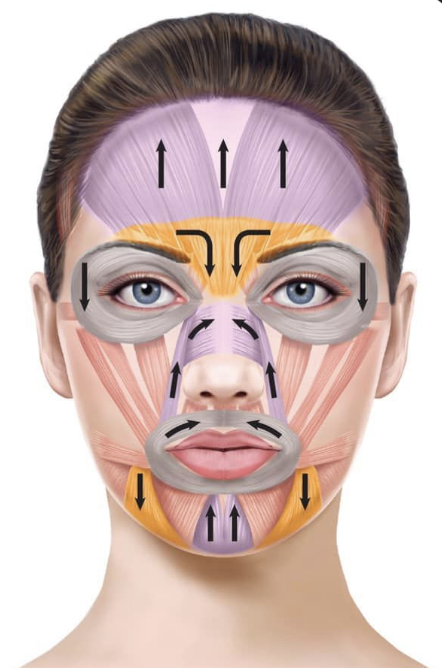How to Lift Your Brows with Botox
When it comes to achieving a subtle, natural-looking brow lift, and opening up the eye area, Botox can be a highly effective treatment. However, understanding how Botox works on different facial muscles is key to ensuring the best results. If you've ever felt like your brows drop or feel heavy after Botox, this blog will explain why—and how to achieve a lifted look instead.
How Your Forehead Lifts Your Brows
The forehead muscle (the purple muscle in the diagram below) is responsible for lifting your eyebrows. Some people use this muscle excessively, especially if they have hooded eyelids or deep-set eyes. Their body has adapted by constantly lifting the brows to compensate for the extra skin on the upper lids.
Think of it like having a sore leg—you’d naturally start limping and putting more weight on the other leg. This compensation happens automatically, without you even realizing it. Similarly, if your upper lids feel heavy, your body instinctively raises your brows using the forehead muscle.
Why Botox in the Forehead Can Sometimes Feel Heavy
If your forehead is doing most of the work to keep your brows lifted, relaxing it with Botox can cause the brows to drop, making your eyelids feel heavier. This happens because the compensatory mechanism is suddenly weakened, and the brows no longer have the extra lift they relied on.
The Best Way to Lift Brows with Botox
Instead of injecting Botox into the forehead, the best approach for patients with heavy brows or hooded eyelids is to target the frown lines (the yellow muscle in the diagram above) and crow’s feet (the grey muscle in the diagram above).
These muscles are called depressor muscles because they pull the brows down. By relaxing them, we remove the downward pull, allowing your brows to naturally lift.
A Helpful Analogy
Imagine your forehead muscle is like a bunch of helium balloons trying to lift your brows up. At the same time, the frown and crow’s feet muscles are pulling those balloons down. If you relax the forehead (pop the balloons), but the depressor muscles are still pulling them down, the brows drop. But if you leave go of the balloons (relax the frown and crow’s feet), they can float higher, ie your brows will lift.
Alternatively, think of your eyebrows as a pulley system. The forehead muscle is pulling the brows up, while the frown and crow’s feet muscles are pulling them down. If you cut the upward pull (by relaxing the forehead), the brows sink. However, if you cut the downward pull (by relaxing the frown and crow’s feet), the brows rise.
Best Botox Strategy for a Brow Lift
For patients who naturally have heavy, low set brows or hooded eyelids,, the best Botox strategy is:
✔️ Have little or no Botox in the forehead – This keeps your natural lifting mechanism intact
✔️ Focus on the frown and crow’s feet muscles – This removes the downward pull, allowing a natural brow lift
✔️ Use a tailored approach – A skilled injector can adjust your treatment plan based on your unique facial anatomy.
Avoiding Brow Drop with Botox
If you’re looking for a subtle and effective Botox brow lift, it’s important to treat the right muscles. Here at Fresh Aesthetics, we carry out an initial consultation to analyse your unique muscle activity, designing a treatment that enhances your natural features—without making your brows feel heavy.
To learn more or book a consultation at our Portadown, Northern Ireland skin clinic, get in touch today!



